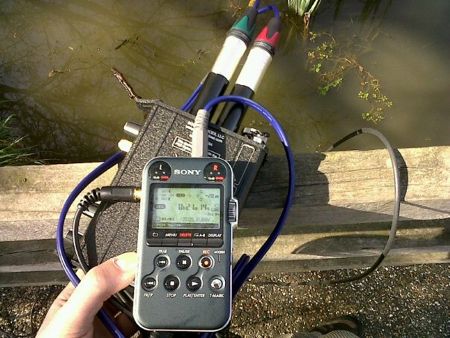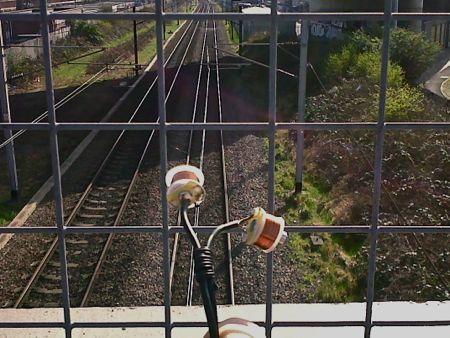The hidden sounds of Tottenham Marshes

I wasn’t that hopeful as just two weeks ago when I had been here doing a hydrophone workshop I had been met with a barrage of silence. The warm weather we’ve had recently though must have awoken the insects as they were in full choral glory as you can hear:
After a while listening to this and explaining and sharing with the equally confused and intrigued passers by (I love the excited looks on their faces as they put on the headphones and listen to the hidden underwater world for the first time!) I decided to move the microphone around a little to see what other insects I could find, if any. I pretty quickly hit upon this really nice stridulation sound:
I then decided to switch to a totally different type of transducer, the electro-magnetic pick-up the kind you can buy from most electrical component retailers as ‘telephone pick up coils’ (which I usually cut out of their protective plastic housing in order to improve the high-frequency response). They work on the same principle as electric guitar pick-ups and instead of vibrations caused by sound they transduce electro-magnetic waves into an analogous electric current.

I made some really nice recordings walking around some electricity pylons and sub-stations but buy far the most interesting sounds came from the nearby railway line. Below are a few excerpts from a longer recording of trains passing beneath me.
Sound Maps
Here are a couple more interesting articles/writings on the subject of sound mapping and sonification:
http://spdf.gsfc.nasa.gov/research/sonification/documents/Chapter1.pdf
http://lhcsound.wordpress.com/
http://makingmaps.net/2008/03/25/making-maps-with-sound/
and of course R. Murray Shafer’s book ‘The Soundscape’ (http://www.amazon.co.uk/Soundscape-Sonic-Environment-Tuning-World/dp/0892814551/ref=sr_1_1?ie=UTF8&qid=1332595003&sr=8-1)
Theremin
http://www.bbc.co.uk/news/magazine-17340257
Sleep Research Facility
Here is the description of the album from the sleep_research faclity website:
“The Nostromo work draws inspiration mainly from R.Scott's 1979 classic sci-fi noir "Alien" - and in particular shots of the interior of the deep-space haulage vehicle the Nostromo during the film's first 5 minutes. Various themes and notions are touched upon by these quiet, haunting scenes, and a conscious decision was made to marry the implications these images carried to an interest in music and sound reflective of spaces as opposed to narrative. The resultant "fictional listening" is a simple exploration of the vast ship in all its quiet darkness. Although apparently silent, it's living human components lying frozen in the deepest of sleep, the ship itself throbs a constant heartbeat from the rumble and pulse of its massive engines, the hum of energy flowing through its circuitry, hydraulic fluids pumping through its quiet mass. But behind these layers hide smaller, more indistinguishable elements (was that something scurrying away off in the shadows…?)”